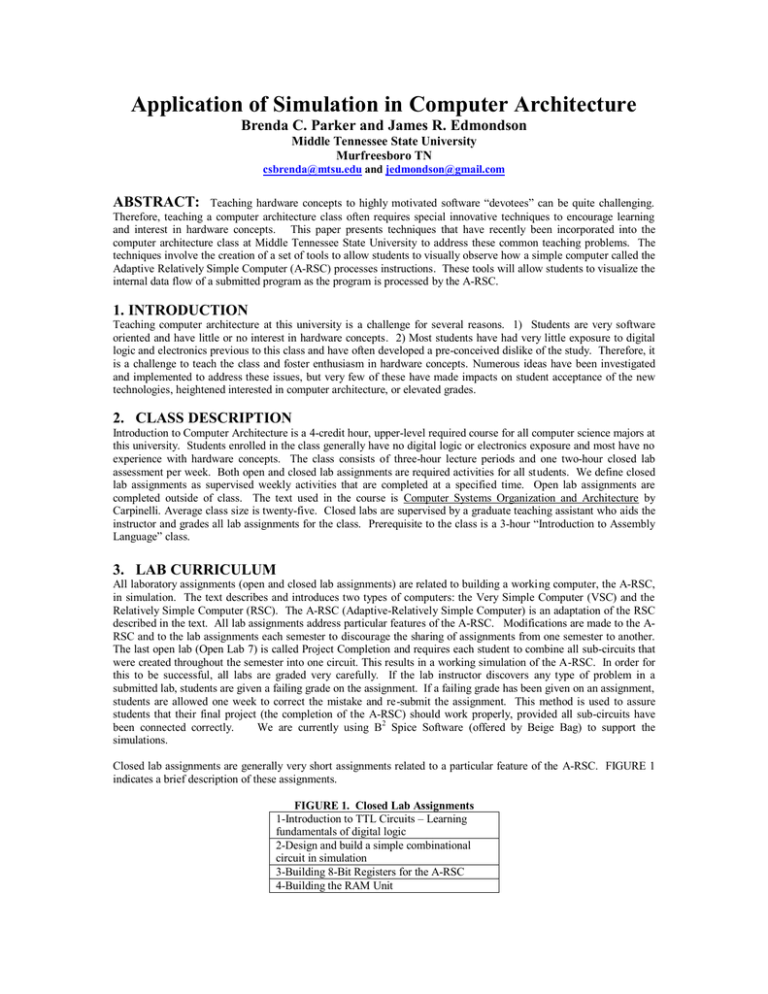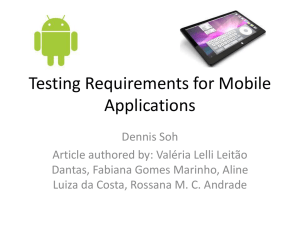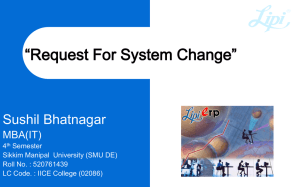Application of Simulation in Computer Architecture ABSTRACT: Middle Tennessee State University
advertisement

Application of Simulation in Computer Architecture Brenda C. Parker and James R. Edmondson Middle Tennessee State University Murfreesboro TN csbrenda@mtsu.edu and jedmondson@gmail.com ABSTRACT: Teaching hardware concepts to highly motivated software “devotees” can be quite challenging. Therefore, teaching a computer architecture class often requires special innovative techniques to encourage learning and interest in hardware concepts. This paper presents techniques that have recently been incorporated into the computer architecture class at Middle Tennessee State University to address these common teaching problems. The techniques involve the creation of a set of tools to allow students to visually observe how a simple computer called the Adaptive Relatively Simple Computer (A-RSC) processes instructions. These tools will allow students to visualize the internal data flow of a submitted program as the program is processed by the A-RSC. 1. INTRODUCTION Teaching computer architecture at this university is a challenge for several reasons. 1) Students are very software oriented and have little or no interest in hardware concepts. 2) Most students have had very little exposure to digital logic and electronics previous to this class and have often developed a pre-conceived dislike of the study. Therefore, it is a challenge to teach the class and foster enthusiasm in hardware concepts. Numerous ideas have been investigated and implemented to address these issues, but very few of these have made impacts on student acceptance of the new technologies, heightened interested in computer architecture, or elevated grades. 2. CLASS DESCRIPTION Introduction to Computer Architecture is a 4-credit hour, upper-level required course for all computer science majors at this university. Students enrolled in the class generally have no digital logic or electronics exposure and most have no experience with hardware concepts. The class consists of three-hour lecture periods and one two-hour closed lab assessment per week. Both open and closed lab assignments are required activities for all students. We define closed lab assignments as supervised weekly activities that are completed at a specified time. Open lab assignments are completed outside of class. The text used in the course is Computer Systems Organization and Architecture by Carpinelli. Average class size is twenty-five. Closed labs are supervised by a graduate teaching assistant who aids the instructor and grades all lab assignments for the class. Prerequisite to the class is a 3-hour “Introduction to Assembly Language” class. 3. LAB CURRICULUM All laboratory assignments (open and closed lab assignments) are related to building a working computer, the A-RSC, in simulation. The text describes and introduces two types of computers: the Very Simple Computer (VSC) and the Relatively Simple Computer (RSC). The A-RSC (Adaptive-Relatively Simple Computer) is an adaptation of the RSC described in the text. All lab assignments address particular features of the A-RSC. Modifications are made to the ARSC and to the lab assignments each semester to discourage the sharing of assignments from one semester to another. The last open lab (Open Lab 7) is called Project Completion and requires each student to combine all sub-circuits that were created throughout the semester into one circuit. This results in a working simulation of the A-RSC. In order for this to be successful, all labs are graded very carefully. If the lab instructor discovers any type of problem in a submitted lab, students are given a failing grade on the assignment. If a failing grade has been given on an assignment, students are allowed one week to correct the mistake and re-submit the assignment. This method is used to assure students that their final project (the completion of the A-RSC) should work properly, provided all sub-circuits have been connected correctly. We are currently using B2 Spice Software (offered by Beige Bag) to support the simulations. Closed lab assignments are generally very short assignments related to a particular feature of the A-RSC. FIGURE 1 indicates a brief description of these assignments. FIGURE 1. Closed Lab Assignments 1-Introduction to TTL Circuits – Learning fundamentals of digital logic 2-Design and build a simple combinational circuit in simulation 3-Building 8-Bit Registers for the A-RSC 4-Building the RAM Unit 5-Design and build 1-bit Registers for the ARSC 6- Build Control Unit I (sequence counter) 7- Build Control Unit II (a decoder circuit to decode instructions) 8- Connect the ALU (arithmetic logic unit) IC and to associated registers 9- Create PLD to generate control signals for RAM 10-Create PLD to generate control signals for counters 11- Create PLD to generate control signals for registers 12-Create PLD to generate control signals for the ALU 13- Create additional control signals Open lab assignments are more challenging assignments that are designed and created outside of class. Some of these labs are related to learning “new” technology so that this technology can be used in the design of more complicated circuits later in the course. Note FIGURE 2 for a brief description of these labs. FIGURE 2 – Open Lab Assignments Lab Assignment 1 - Learn to use a logic simulator 2 – Study PLDs and their purpose 3 – Create PC (program counter) and AR (address register) 4 – Connect all registers and counters and design connections between each device 5 – Learn assembly language for the A-RSC and write a program for the A-RSC 6 – Combine circuits to build one Control Unit to control all inputs to the bus line created in LAB 4 7 – Project Completion Combine all circuits and run a simulation of the program written in Lab 5 4. PROBLEMS Over the years we have experienced problems with this approach in teaching computer architecture. We divide these problems into two categories: technical construction problems with the final project and student motivation. First, we describe some of the technical problems. Students are given ample aid and advice with all labs through the work of the graduate teaching assistant assigned to this class. Therefore, the most pressing technical problems occur with the open lab assignments. By far, the most challenging assignment is Open Lab 5. This lab requires students to write an assembly language program for the ARSC. Students are asked to write 3 separate programs for the A-RSC where each program specifically tests different components of the ALU. Some students have problems with this lab because they do not fully understand the architecture of the A-RSC. They often forget or simply do not understand how the A-RSC stores multi-part instructions, for example. Quite often these students do not realize their mistake until the final project is due. At this time, they are at a loss because they do not understand why their simulation does not work properly. Most often the reason that the simulation does not work is that their assembly language program is written incorrectly. Another technical problem is related to Open Lab 7 - the completion of the A-RSC. The students finish this lab and test the final circuit using their program created in Open Lab 5 and realize that there is an error “somewhere” in their circuit. Debugging their circuit is a tremendous job and quite often students do not understand the microcode for the A-RSC well enough to know where to start looking for the “bug”. Usually, the problem is related to how the different components were connected together. Student motivation has been a problem. We believe that the main problem with motivation is that many students have trouble visualizing and understanding how the A-RSC executes instructions. Also, very often, students are bored with the whole concept of hardware issues. As a result of these problems, we determined to add animation features online to reduce some of the technical problems encountered by the students. We also felt that using animation would aid in increasing student motivation and interest. 5. NEW COURSE ATTRIBUTES It has been well documented that the usage of animation aids in helping students learn and understand traditional algorithms in computer science [1,6] . It has also been noted that visualization techniques have been used to enhance learning in different operating systems concepts as well [2]. Visualization techniques have become even more popular recently because of the popularity of the World Wide Web and the usage of JAVA applets [3]. With these studies in mind, we determined that providing animation techniques online might aid our students in overcoming the problems noted above. A “Relatively Simple CPU Simulator” is available on our textbook’s web site, but this simulator could not be used with our class because of the adaptations we implement each semester. We had two key goals in mind: 1) allow students to submit their assembly language programs and determine if their program contained any semantic errors and 2) allow students to visually see the transfer of data throughout the computer as the “computer” executes their code. Since our department strongly encourages undergraduate research projects, research projects were awarded to students to design and create a set of simulation tools to be used in the architecture class. Two projects were tested and used in the class: the RSC Simulator and the RSC Emulator. The RSC Simulator was the first generation of our simulator ideal. Shortly after its deployment, problems were encountered, and ideas for the core design of the Emulator began emerging. However, a new tool was not immediately developed to address these issues. We felt that an important aspect to the design of the new Emulator was to allow past and present class members to discuss and contribute to the design of the new Emulator. This allowed all students to take an active part in the project. This dialogue was especially important to the instructor of the class since designers of animation concepts usually gain a deeper understanding of the concepts involved [4,5]. Shortly after goals were established for the new Emulator, the co-author investigated research funding avenues and was awarded research monies through the university’s URSCP program to design, document, build and support the development of an emulator project to be used in the class. We now describe the evolution and design of the emulator and the results of its use. 6. THE RSC EMULATOR The RSC Simulator had several flaws that needed to be addressed by the new Emulator: occasional malfunction of the Arithmetic Logic Unit (ALU), the reliance on bytecode-only input, few emulation options, and frequent program abortion (displayed red X’s). Over the next few semesters, students offered assemblers and compilers that produced correct code, but none of them offered the vision of emulation needed by the instructor. The development of the RSC Emulator benefited from key observations of what the RSC Simulator did, did not do, and should have done. High priority goals for the development of the RSC Emulator were as follows: 1. 2. 3. Create a simple, elegant user interface that any student could easily pick up and use. Create a seamless integration of a compiler, debugger, and emulator in one package. Provide universal accessibility, automation, robustness, and flexibility. Early in the planning stages, Java was selected as the platform. The Swing libraries provided professional GUI elements, forced object oriented design, and applets provided the accessibility that both instructor and student developer wanted. However, before building the new Emulator, observations of known problems were observed: Lessons learned from the RSC Simulator: 1. 2. 3. 4. 5. 6. 7. Two intercommunicating applets may experience some problems (the red X’s). Although lines and colors can be helpful, too many of either element can distract the user. The interface needed to be simplified. The emulation needed to be able to step by instruction and not just by clock tick (microinstruction). A component view could be added to best help students visualize microinstruction operations. The compiler should be able to produce code used by the B2 Spice program. More features should be added. Students will use the RSC Emulator to type in an assembly language program, compile it and then try to discover logic problems with their assembly code by watching the Emulator execute their program. As students watch the Emulator execute their program, they are able to see that each microinstruction is executed properly and quickly diagnose any problems inherent in their assembly code. To facilitate this, the student has the option of watching the execution in Edit View, Virtual Machine View, Component View, Message View and B2 Spice View. Each portal to the Virtual ARSC is designed to maintain familiarity and similar feature sets among all views. Further included are register and memory lookups and byte code views that can track exactly where the Emulator is throughout each step of program execution. A single color system was introduced for each view and indicates write operations only. This color coding system is used to notify students of changes in register values. If further investigation is needed to learn how or why the register or component was changed, the student can simply use the Component View to determine what machine components are involved in the data manipulation. A sample diagram of the Emulator in Virtual Machine View and Component View is shown in FIGURE 3 and in FIGURE 4 below. FIGURE 3 denotes changes in the IR (instruction register), the TR (temporary register), the DR (data register), the AR (address register) and the PC (program counter). Note that components are grouped together logically in the Emulator according to frequent access: the ALU is affected by the AC (accumulator) and the R register, RAM needs signals from the AR which is controlled by the PC register, etc. The instruction being executed in the figures is a JUMP to address 0005. The DR register contains the high word of the address to jump to, and the TR register contains low word information. Both registers are merged into the PC register to subsequently give the AR the address of the next word to be obtained from RAM. FIGURE 3 – RSC Emulator Color Coding System on Virtual Machine View FIGURE 4 below presents the same instruction execution but is viewed through the RSC Emulator’s Component View. This portal allows the student to view the architecture by microinstruction. Here you can see that 6 microlines of microinstructions which are executed by the A-RSC in a JUMP instruction. For example, the top figure notes that the AR is loaded with the PC. The next figure indicates the next micro-operation where the DR is loaded with RAM[AR] and the PC is incremented. FIGURE 4 – RSC Emulator Color Coding System on Component View Because of a growing trend in the usage of IDEs throughout the student’s education, several debugging features were added to every view to facilitate easy debugging. These features were modeled on the successful attributes of other well known IDEs and include the ability to watch variable locations, registers, and even what instruction will be executed next. FIGURE 5 below shows this aspect of the development environment, which is included at the bottom of the Edit, Virtual Machine, and Component Views. FIGURE 5 – The Byte Code and Register/Memory Lookup The Register/Memory Lookup in FIGURE 5 complements the information discernable from the Virtual Machine and Component Views. Included in this feature set is the ability to lookup specific memory addresses to see if any changes have taken place. Here, the student is observing the data contained at address 0003 and 0004 to track their own variables (address 0003 contains 32 and address 0004 contains a 33). The Byte Code panel is included to show the exact machine code that will be executed next. In this case, the next instruction (see the selected portion) to be executed is 01 (Load Accumulator instruction). So, 01 03 00, indicates that the accumulator should be loaded with the contents of memory address 0003. To further facilitate full emulation and complete the debugging experience, the RSC Emulator includes the ability to step backwards in the execution process. By pressing the “Prev Instruction” button, students may go backwards in program execution up to 10 times. 7. THE COMPILER In a previous implementation of our Simulator concept, students were provided with an assembler module that checked for proper hexadecimal code before executing in a machine level view of the system. This meant that for an intended program, students had to visualize their program in an assembly or higher level language implementation and then hand write the hexadecimal in little Endian format. So many problems occurred with this technique that an easy-to-use assembly language was developed with an appropriate hand-written compiler for the small instruction set. The benefits of this design approach are more obvious when presented with the alternative. In the previous RSC Simulator, students were asked to hand write code to solve a particular problem. For example, the following code would be written to add two numbers and display the result. (The comments have been added to help the reader, but were not allowed in the actual assembler program.) 01 0A 00 03 01 0B 00 08 07 00 // Load Accumulator with the data at address 000A // Move the contents of the Accumulator to the R Register // Load Accumulator with the data at address 000B // Add the contents of the R Register to the contents of the Accumulator // Output the contents of the Accumulator // Halt the system The compiler was built to include a wide variety of programming features to provide students with the ability to increase the breadth and diversity of their applications. The overall goal was simplicity and functionality while still forcing the student to completely understand the hardware and the order instructions must be called. For the student, the compiler supports the ability to use symbols for variable or jump locations, comments for maintenance, mixed case instructions and spacing for readability, and the ability to use variables, little Endian style addresses, or Big Endian style addresses for ease-of-use. For the instructor, the compiler supports the ability to change the instruction set and the subsequent bytecode to discourage sharing of files between semesters. The same program above can now be written as follows (and the comments can be included in the student’s code): LDA MOVR LDA ADD OUT HALT A B ; Load the Accumulator with the data at address A ; Move the contents of the Accumulator to the R Register ; Load the Accumulator with the data at address B ; Add the contents of the R Register to the contents of the Accumulator ; Output the contents of the Accumulator ; Halt the system FIGURE 6 below shows the Edit View. This portal provides the student with the ability to create and edit their program. After the code has been edited, the user of the program should then press the Compile button which invokes the RSC Compiler on the code contained in the Edit View. FIGURE 6 – The Edit View From the program code, the compiler generates byte code to be executed by the Emulator and B 2 Spice code which can be imported directly into the student’s RAM unit for execution on their semester project. In order to execute the compiled code in the RSC Emulator, the student may simply press the “Execute” button. 8. Results, Comments, and Observed Behavior The RSC Emulator has been well accepted by the fall architecture class, and although it is too early to correlate grade improvements and machine level understanding, the majority of students are certainly more enthusiastic about hardware concepts and their final semester projects than recent classes. The most significant change observed by the instructor was the amount of support time required by the teacher and lab assistant for program related questions. The students appeared to have fewer problems programming their machines, which resulted in both teacher and lab assistant having more time to focus their efforts more easily on the semester’s final project. We believe we can attribute this progress to the ease-of-use of the RSC Emulator and the subsequent improvement in student comprehension and retention. Students were asked to comment on their enjoyment and use of the emulator. Selected comments included: “The emulator is awesome”, “I found that the emulator was a MUST HAVE tool. It allowed me to debug and troubleshoot my circuit quickly”, “Watching how the emulator ran through the lines of codes allowed me to get a stronger understanding of how the RSC processes commands”. 9. Conclusions and Future Work The learning experience for the designers of this project has been very rewarding. Many of the problems that we have experienced in this class have been alleviated with the use of these visual aids. Students can now verify that their program was written correctly before the completion of their final project. The visual aids have helped students understand the microcode to a greater extent and as a result our classes appear to be more interested in hardware concepts. Grades have improved and the enthusiasm for the lab assignments and the course in general has increased greatly. We have numerous plans for future work related to this project. In the near future we hope to develop an online submission system for all digital designs and require the usage of the simulation tools more extensively. We plan to install counters to determine the usage of the simulation tools and analyze and provide statistical evidence regarding its benefits. We also wish to create an instructor interface so that portions of the microcode and computer components can be easily changed from one semester to another. Also, because we have learned so much from the development of the RSC Emulator, we hope to encourage and propose more student research projects in hardware and simulation areas. 10. References [1]Lawence, A., Badre, A., and Stako, J. Empirically Evaluating the Use of Animations to Teach Algorithms. Technical Report GIT-GVU-94-07 (Georgia Institute of Technology, Atlanta, GA, 1994). [2] Khuri, S., Hsu, H., Visualizing the CPU scheduler and Page Replacement Algorithms, Proceedings of SIGCSE Technical Symposium on Computer Science Education’99, 1999, pp227-231. [3] Naps, T., Algorithm Visualization Served off the World Wide Web: Why and How. Proceedings of SIGCSE/SIGCUE’96, 1996, pp. 66-71. [4] Naps, T. and Chan, E., Using Visualization to Teach Parallel Algorithms. Proceedings of SIGCSE Technical Symposium on Computer Science Education’99, 1999, pp232-236. [5] Rodger, Susan, “Integrating Animations into Courses”, Proceedings of SIGCSE/SIGCUE Conference on Integrating Technology into Computer Science Education, Barcelona, Span, June, 1996. [6] Stasko, J., Badre, A. and Lewis, C., “Do Algorithm Animations Assist Learning? An Empirical Study and Analysis”, Proceedings of INTERCHI ’93 Conference on Human Factors in Computing Systems, (Amsterdam, Netherlands, April, 1993.




